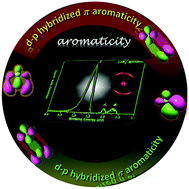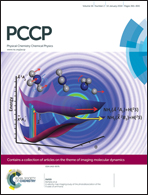Observation of d–p hybridized aromaticity in lanthanum-doped boron clusters†
Abstract
The concept of aromaticity has been advanced beyond the framework of organic chemistry, and multiple aromaticity (σ, π, and δ) has been observed to account for the highly symmetric structures or unusual stability of the clusters. In the present study, the electronic structures and chemical bonding of small monolanthanum boride clusters are investigated using photoelectron imaging spectroscopy and first principles electronic structure calculations. Accurate electron affinities of 1.32 ± 0.04 and 1.13 ± 0.06 eV for the neutral LaB2 and LaB3 clusters are obtained by the vibrationally-resolved photoelectron spectra of the LaB2− and LaB3− clusters, respectively. It is shown that LaB2− and LaB3 exhibit enhanced stability in their respective cluster series, as evidenced from the calculated removal energies and HOMO–LUMO gaps. Molecular orbital analysis discloses that these two clusters possess doubly aromatic characters (σ and π), responsible for their enhanced stability. Interestingly, unlike conventional σ-, π-, and δ-aromaticity formed by the delocalization of unhybridized p or d orbitals, the σ and π delocalized molecular orbitals shown here are formed through the effective overlap between the 5d atomic orbital of the La atom and the p orbitals of the remaining boron atoms, representing an intriguing d–p hybridized aromaticity.

- This article is part of the themed collection: Imaging molecular dynamics

 Please wait while we load your content...
Please wait while we load your content...